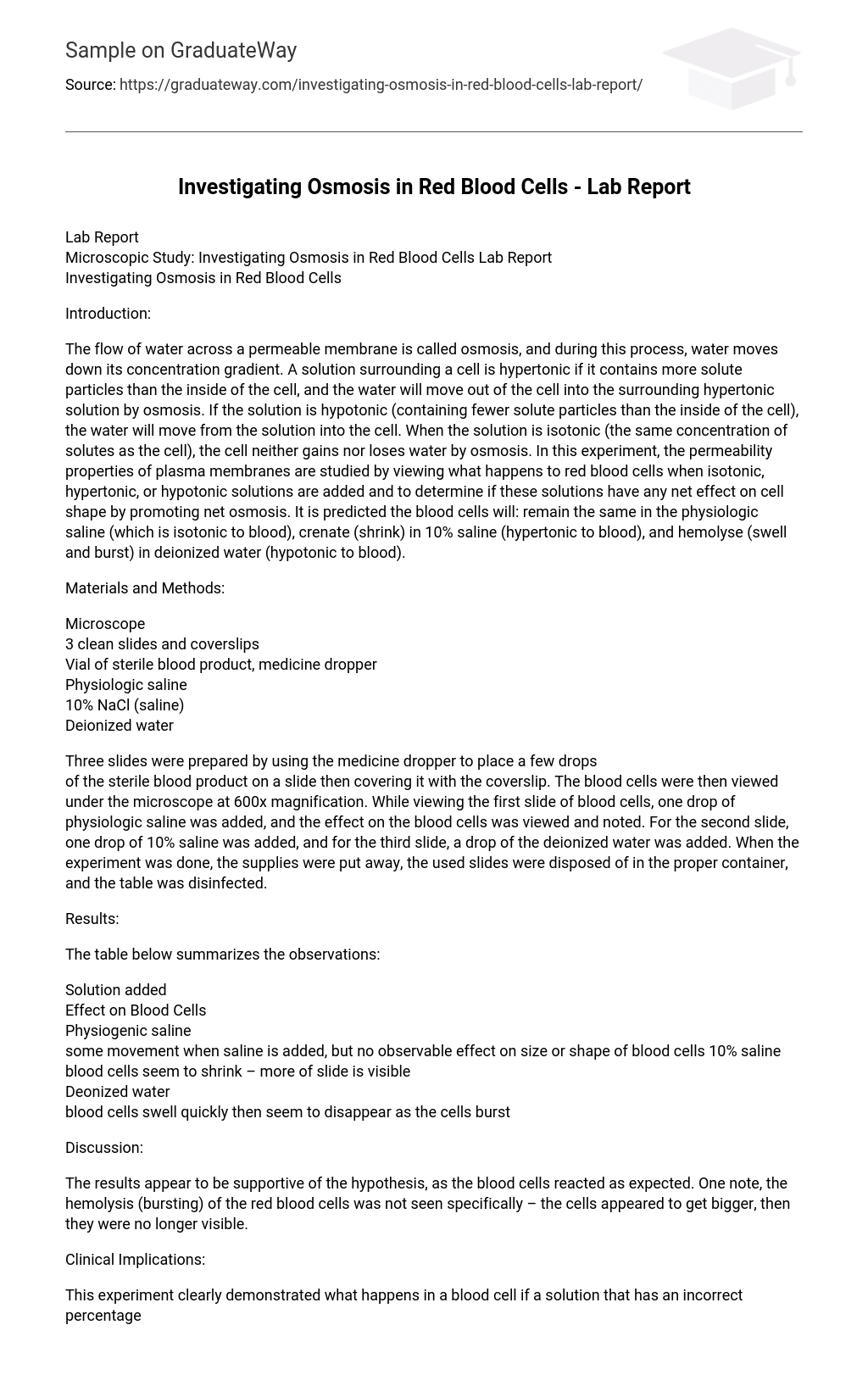Lab Report
Microscopic Study: Investigating Osmosis in Red Blood Cells Lab Report
Investigating Osmosis in Red Blood Cells
Introduction:
The flow of water across a permeable membrane is called osmosis, and during this process, water moves down its concentration gradient. A solution surrounding a cell is hypertonic if it contains more solute particles than the inside of the cell, and the water will move out of the cell into the surrounding hypertonic solution by osmosis. If the solution is hypotonic (containing fewer solute particles than the inside of the cell), the water will move from the solution into the cell. When the solution is isotonic (the same concentration of solutes as the cell), the cell neither gains nor loses water by osmosis. In this experiment, the permeability properties of plasma membranes are studied by viewing what happens to red blood cells when isotonic, hypertonic, or hypotonic solutions are added and to determine if these solutions have any net effect on cell shape by promoting net osmosis. It is predicted the blood cells will: remain the same in the physiologic saline (which is isotonic to blood), crenate (shrink) in 10% saline (hypertonic to blood), and hemolyse (swell and burst) in deionized water (hypotonic to blood).
Materials and Methods:
Microscope
3 clean slides and coverslips
Vial of sterile blood product, medicine dropper
Physiologic saline
10% NaCl (saline)
Deionized water
Three slides were prepared by using the medicine dropper to place a few drops
of the sterile blood product on a slide then covering it with the coverslip. The blood cells were then viewed under the microscope at 600x magnification. While viewing the first slide of blood cells, one drop of physiologic saline was added, and the effect on the blood cells was viewed and noted. For the second slide, one drop of 10% saline was added, and for the third slide, a drop of the deionized water was added. When the experiment was done, the supplies were put away, the used slides were disposed of in the proper container, and the table was disinfected.
Results:
The table below summarizes the observations:
Solution added
Effect on Blood Cells
Physiogenic saline
some movement when saline is added, but no observable effect on size or shape of blood cells 10% saline
blood cells seem to shrink – more of slide is visible
Deonized water
blood cells swell quickly then seem to disappear as the cells burst
Discussion:
The results appear to be supportive of the hypothesis, as the blood cells reacted as expected. One note, the hemolysis (bursting) of the red blood cells was not seen specifically – the cells appeared to get bigger, then they were no longer visible.
Clinical Implications:
This experiment clearly demonstrated what happens in a blood cell if a solution that has an incorrect percentage of solutes is delivered into the blood stream. This was a vivid visual image for any clinical practitioner to realize how important it is to get the measurement exactly right when
administering products into the bloodstream. Another consideration would be to make sure blood or blood products are stored in the proper medium so they will be as healthy as possible when needed.
References:
Marieb, Elaine N. and Mitchell, Susan J. Mitchell. Human Anatomy & Physiology Laboratory Manual. 10th ed. San Francisco, CA: Benjamin Cummings (an imprint of Pearson), 2012. Print.





